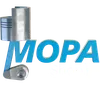WARNING UNIT Display for Marine and Diesel Engines
A display in the engine monitoring and alarm system is the operator’s primary interface to the machine room. Within propulsion plants and gensets, the display visualizes key parameters, alarm states, and trends so crews can act fast and decisively. In the article category “Display,” we focus on robust, sunlight-readable, and vibration-resistant human–machine interfaces designed to work hand in hand with the ship’s WARNING UNIT. These modules consolidate sensor data from the engine control system and translate it into clear, actionable information for bridge and engine control room personnel—an essential link between complex engine logic and safe, efficient operation.
Technical function of the WARNING UNIT display in a marine engine and diesel engine
The display receives processed alarm and status signals from the WARNING UNIT in a marine engine or diesel engine installation, typically via industrial communication protocols such as CAN J1939, Modbus RTU/TCP, or NMEA 2000. It renders real-time values for lube oil pressure, coolant temperature, charge air pressure, exhaust temperatures by cylinder, fuel pressure, differential filters, and RPM. It also prioritizes and timestamps alarm events, supports acknowledge and reset functions, and can interface with horns and beacons through the WARNING UNIT’s I/O architecture. By aggregating and presenting this information clearly, the display supports faster diagnosis, minimizes time to corrective action, and helps crews keep engines within safe operating envelopes.
In practice, the display’s role extends beyond simple readout. Event logging, trend pages, and threshold-based color changes provide context that operators need to decide whether an engine can continue at reduced load or must be shut down. High-brightness, dimmable backlights ensure readability on the bridge at noon and at night. Rugged housings with IP65–IP67 facia sealing, wide operating temperatures (e.g., −20 °C to +70 °C), and high EMC immunity allow reliable operation in harsh marine environments with vibration, salt spray, and electrical noise. Touch or keypad inputs are optimized for gloved use, while firmware ensures alarm latching logic is consistent with the WARNING UNIT diesel engine configuration. When sourcing WARNING UNIT OEM parts and compatible displays, consistency of communication parameters (e.g., SPNs/PGNs on J1939) is critical to error-free integration.
- · Sunlight-readable, dimmable screens for bridge and ECR use.
- · Robust IP65–IP67 front protection and vibration-resistant design.
- · Clear alarm hierarchy with acknowledge/reset functions.
- · Event logging and trend visualization for faster troubleshooting.
- · Seamless CAN J1939, Modbus, or NMEA 2000 communication.
- · Wide temperature range and high EMC immunity for marine service.
- · Form-fit mounting options and gloved-operation controls.
Importance of the WARNING UNIT display for reliable engine operation
Reliability and service life depend on staying within thermal, lubrication, and mechanical limits—and the display makes those limits visible. Without a properly functioning display, minor anomalies can progress unnoticed: a slow drop in lube oil pressure can accelerate bearing wear; marginal coolant temperature increases can lead to liner cavitation; high exhaust temperatures can damage turbochargers or exhaust valves. The WARNING UNIT and display together provide early warnings and escalation, helping prevent costly off-hire events or unplanned dry-dock work.
Worn or unsuitable displays introduce risk. Dim backlights or faded color palettes can mask alarms. Unstable communication can cause intermittent data loss, leading crews to chase non-existent faults or overlook real ones. Touch drift, cracked front glass, or corroded connectors degrade operator interaction and environmental sealing. Over time, mismatched firmware can display incorrect units, scaling, or alarm thresholds, undermining the WARNING UNIT marine engine logic and compromising safety. Keeping the display in optimal condition is therefore not cosmetic—it directly affects situational awareness and decision-making under pressure.
OEM spare parts for displays in WARNING UNIT systems: performance, reliability, and lifecycle benefits
Using OEM spare parts suitable for the display category ensures the display continues to match the WARNING UNIT’s specifications and the engine builder’s control philosophy. Mechanical fitment—mounting holes, bezel depth, gasket profile—remains exact, preserving IP sealing against moisture and salt. Electrical and communication compatibility is maintained, avoiding conflicts with CAN identifiers, Modbus registers, or alarm latching logic. Screen brightness, color calibration, and anti-glare coatings remain consistent with bridge and ECR lighting conditions, preserving clarity and reducing operator fatigue.
Beyond technical fit, OEM spare parts suitable for displays protect budgets and uptime by minimizing commissioning time and reducing the risk of intermittent faults. Firmware alignment ensures that new displays read the same parameter maps and alarm priorities as the existing WARNING UNIT diesel engine setup, eliminating re-engineering or field reprogramming. Lifecycle alignment with the engine platform supports long-term availability of identical or approved successor parts, simplifying fleet standardization and spares holding.
MOPA: fast, secure supply of OEM parts for WARNING UNIT and display systems
MOPA is a reliable partner for OEM spare parts in the Display category, serving operators of diesel and gas engines worldwide. We prioritize speed—rapid quotations, prompt availability checks, and expedited logistics—to minimize downtime. Our focus on quality and security means traceable sourcing, careful ESD- and moisture-safe packaging, and accurate cross-referencing against engine type, control system version, and protocol settings. Whether you need a drop-in panel display for a WARNING UNIT marine engine installation or assistance aligning firmware to a specific controller, MOPA delivers the right OEM parts with confidence and technical clarity.
Conclusion: WARNING UNIT display and OEM parts for marine and diesel engines
The display is the visible face of the WARNING UNIT, turning sensor data into decisions that protect engines and people. Keeping this component precise, readable, and fully compatible preserves performance, efficiency, and safety across the vessel’s lifecycle. Selecting OEM spare parts suitable for displays ensures form-fit-function integrity, stable integration, and cost-effective reliability for your marine and diesel engine assets.





